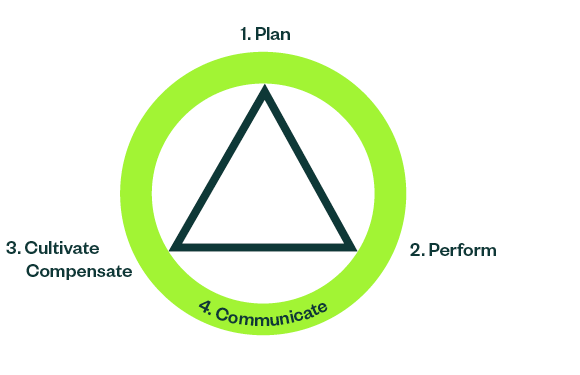
The differences between Tribes across the United States are as expansive as those between the most diverse cities, counties, states, not-for-profits, or businesses.
Tribes range from urban to rural, from complex to relatively simple, from large Tribal enrollment to smaller, and from financially successful to struggling. These differences contribute to a present in which some Tribes benefit from sizeable gaming operations or significant natural resources while others rely primarily on federal funding.
Regardless, every Tribe can improve its performance—and every Tribe can be a high performer. There are four attributes that all high-performing organizations share, and Tribes and their businesses are no exception:
- A clear plan for moving forward
- A focus on performance measurement
- A strategy for cultivating and compensating employees
- A commitment to communication

A key to success is achieving alignment between these four elements as shown above. Let’s take a closer look at each of these four attributes.
Planning
Every Tribe should be guided by a strategic plan, which defines a roadmap for moving from point A to point B.
The plan should reflect a long-term vision to guide strategic decisions, a thorough understanding of what got your organization to its current state, and a clear path to your desired future state.
It should address both the Tribe’s goals in basic services to membership as well as goals for its business enterprises.
A comprehensive strategic plan should encompass the following components:
- Mission and core values
- Long-range vision
- Long- and short-term goals
- Historical review and a strengths, weaknesses, opportunities, and threats (SWOT) analysis
- Community needs
- Annual and quarterly action plans
Strategic plans can play a critical role in guiding the priority utilization of new funding sources, such as the American Rescue Plan Act (ARPA).
Performance
Performance metrics should be in place to monitor performance against your Tribe’s plan. Performance metrics can be developed for each facet of your governmental and enterprise operations, and each metric should tie back to your strategic goals and objectives.
For example, if a strategic goal is to increase the availability of affordable housing on the reservation, performance measurement might mean publishing a monthly list of applicants waiting for homes on the reservation and the inventory of homes.
The review and comparison of these lists from month to month can help determine whether the goal is being met. Think of performance at three tiers: enterprise, department or enterprise, and individual. Performance at each tier is important to the success of the organization, and there should be alignment between the tiers.
Cultivating and Compensating Employees
To attract, retain, develop, and incentivize the workforce that will help you meet your Tribe’s goals and objectives, you must determine what resources and competencies will be required at each level and in each facet of your organization.
Accordingly, you’ll need to define the following:
- Recruiting needs for entry-level and experienced personnel
- Career paths to support the progression of both managerial and technical personnel
- Compensation programs that create incentives for employees to accomplish goals and objectives
- Training programs to help employees reach their maximum potential
It’s critical that employees are aware of and understand how to navigate their career path options and benefit from performance-based compensation.
This can help improve retention and ultimately help the Tribe achieve its goals and enhance the lives of Tribal members and employees.
Communication
Together, planning, performing, and cultivating and compensating your people form the cornerstones of high-performing Tribes. However, without communicating how these three elements work together, you won’t achieve the engagement required to be a truly high-performing organization.
Communication is the glue that binds these items together and helps your employees understand how they individually and collectively contribute to the success of your organization.
Communication needs to be crisp, clear, structured, and regular.
Performance Assessment: Putting It All Together
A performance assessment conducted by an outside, unbiased expert that understands Tribal governments and enterprises and offers a breadth of best practices to draw from is a great way to assess your Tribe and position it for a successful and sustainable future.
The assessment shouldn’t only focus on evaluating the extent to which these four attributes exist; it should also encompass a comprehensive assessment of the operational and organizational performance of each component of the Tribe. These assessments are sometimes referred to as performance audits.
The results of the operational and organizational assessment will directly inform the following:
- What the Tribe’s strategic plan needs to address
- What performance measures will help to monitor plan implementation
- What employee cultivation, training, and compensation actions are needed to resource plan execution
A communication strategy will tie these elements together in a way that builds awareness and buy-in from your employees.
If your employees understand how your strategic plan, performance expectations, and people are aligned—and that understanding is reinforced through regular communications—then you’ve created a high-performing organization. The rest is simply execution.
We're Here to Help
Contact your Moss Adams professional for help developing a strategic plan, performance metrics, and systems to enable your employees to thrive.